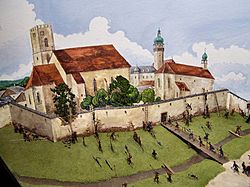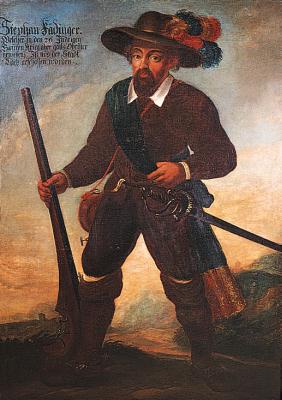Upper Austrian peasant war of 1626 facts for kids
Quick facts for kids Upper Austrian peasant war |
|||||||
|---|---|---|---|---|---|---|---|
| Part of The Thirty Years' War | |||||||
 Peasant rebels attacking the Peuerbach stronghold |
|||||||
|
|||||||
| Belligerents | |||||||
| Austrian Rebels | |||||||
| Commanders and leaders | |||||||
| Stefan Fadinger † Christoph Zeller † |
|||||||
| Strength | |||||||
| c. 40,000 | 40,000+ | ||||||
| Casualties and losses | |||||||
| 12,000+ | 10,000+ | ||||||
The Upper Austrian Peasant War (also known as Oberösterreichischer Bauernkrieg in German) was a big uprising in 1626. It was led by farmers who wanted to free their home, Upper Austria, from the control of Bavaria. This war happened during the time of the Thirty Years' War.
The main reason for the war was that the Bavarian rulers were trying to make everyone in Upper Austria follow the Catholic faith. This was a big problem because many people in the area were Protestant.
Contents
Why Did the War Start?
Religious Changes in Upper Austria
At the start of the Thirty Years' War, Upper Austria was given to Bavaria by the House of Habsburg. The new Bavarian ruler believed in a rule called cuius regio, eius religio. This meant that the ruler's religion would be the religion of everyone living in that area. So, Bavaria tried to change Upper Austria to the Catholic faith.
In May 1625, a Protestant priest in the town of Frankenburg am Hausruck was replaced by a Catholic priest from Bavaria. This made the local people very upset. An armed group of people rose up and forced the new priest to leave.
The Frankenburger Würfelspiel Incident
After the uprising, the people who had protested were worried about what Bavaria would do. They gave up three days later. Adam von Herberstorff, who was the Bavarian leader in Upper Austria, gathered all the men from the region. About 5,000 men came to a field near Frankenburg.
Among them were 36 men who had led the protest. The court decided that these men should be punished. However, they said that half of them could go free. Two men would step forward, and they would roll dice to decide who would be punished and who would be set free. This event is known as the Frankenburger Würfelspiel (Frankenburg Dice Game).
How the Peasants Prepared for War
Herberstorff thought this harsh decision would scare the farmers. But it did the opposite. It made them even more angry and sympathetic to the idea of rebellion. For the next year, the farmers secretly got ready for war.
They recruited one man from almost every farm house. They also gathered weapons and learned how to fight together. They planned to attack on a holiday called Pentecost.
The War Begins
The war actually started two weeks earlier than planned. Bavarian soldiers tried to steal a horse in a town called Lembach im Mühlkreis. In response, a group of farmers who were on a religious journey nearby quickly gathered. They attacked and defeated the 25 Bavarian soldiers stationed there.
This group of farmers grew bigger as they marched towards Peuerbach. There, they faced Herberstorff and his soldiers. Even before the full peasant army was ready, some groups of farmers attacked and were quickly defeated. On the battlefield, new leaders for the region were chosen right away.
Key Battles and Leaders
The peasant army grew to about 5,000 fighters. They went on to surround and attack several towns like Eferding, Wels, Kremsmünster, and Steyr. Finally, they reached Linz. Linz did not give up, even though it was defended by only 150 Bavarian soldiers.
During the attack on Linz, the main leader of the rebels, Stefan Fadinger, was shot. He died on July 5, about two weeks after being shot.
The End of the Rebellion
It took several months for Bavaria to send more troops. These new soldiers, led by Pappenheim, arrived at the end of August to help Linz. Steyr was taken back by Bavarian forces on September 26, and Wels on September 27.
The war continued until winter arrived. The fighting left the countryside badly damaged. The farmers who survived were then forced to feed the 12,000 Bavarian soldiers who stayed in the area for the winter. Many of the leaders of the rebellion were captured and punished in the months that followed.



